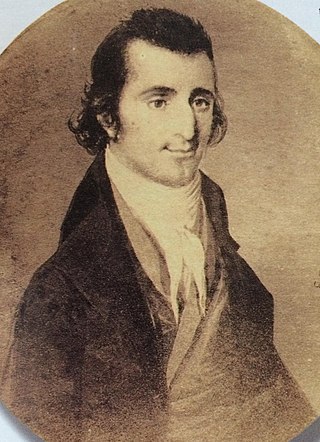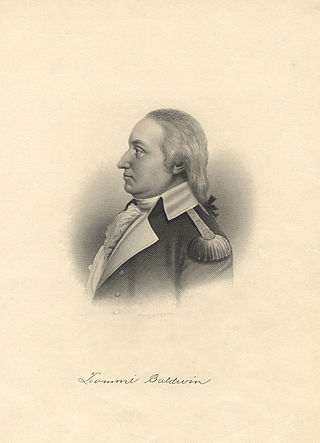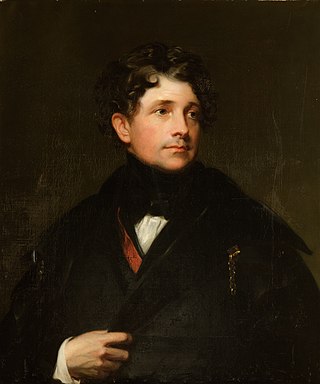
Captain Gamaliel Bradford, was a sea captain, privateersman, and later a prison warden who earned notoriety during the Quasi-War with France commanding two privately owned and armed merchant vessels known as letters of marque. Born November 4, 1763, in Duxbury, Massachusetts, he served in the 14th Massachusetts Regiment at a young age during the American Revolution, initially as a private and eventually was commissioned a lieutenant in the Continental Army. At the end of the war he went to sea as a mariner and by the 1790s commanded merchant vessels as a master mariner.
The 11th Massachusetts Regiment was raised on September 16, 1776, under Colonel Ebenezer Francis at Boston, Massachusetts. The 11th Mass. would see action at the Battle of Hubbardton, Battle of Saratoga and the Battle of Monmouth. The regiment was disbanded on January 1, 1781, at West Point, New York.
The 2nd Massachusetts Regiment, also known as Thomas' Regiment and Bailey's Regiment, was a unit of the Massachusetts Line in the 1777 establishment of the Continental Army. It was a successor to a number of Massachusetts provincial regiments from the army's 1775 establishment, and was known as the 23rd Continental Regiment during the 1776 establishment. It was raised on April 23, 1775, under Colonel John Thomas outside of Boston, Massachusetts; the commanding officer for much of its existence was Colonel John Bailey. The regiment would see action at the Battle of Bunker Hill, New York Campaign, Battle of Trenton, Battle of Princeton, Battle of Saratoga and the Battle of Monmouth. The regiment was also encamped during the winter of 1777–1778 at Valley Forge. The regiment was disbanded on November 3, 1783, at West Point, New York.
The 3rd Massachusetts Regiment also known as the 24th Continental Regiment, Heath's Regiment, and Greaton's Regiment, was raised on April 23, 1775, under Colonel William Heath outside Boston, Massachusetts. When Heath was promoted to brigadier general in June 1775 the regiment came under the command of Colonel John Greaton. The regiment would see action at the Battle of Bunker Hill, Battle of Trois-Rivières, Battle of Valcour Island and the Battle of Saratoga. The regiment was disbanded, on November 3, 1783, at West Point, New York. Lineage carried on by the U.S. 104th Infantry Regiment.
The 5th Massachusetts Regiment also known as the 19th Continental Regiment was raised on April 17, 1775, under Colonel Mansfield outside of Boston, Massachusetts. The regiment saw action at the Battle of Concord, Battle of Bunker Hill, New York Campaign, Battle of Trenton, Battle of Princeton. Colonel Rufus Putnam took command in January 1777 and participated in the Battle of Saratoga.This regiment was commanded by Colonel John Mansfield, of Lynn, who left the service on September 15, 1775. From then until the end of the year the regiment was commanded by Lieutenant Colonel Israel Hutchinson, of Danvers. It served in the siege of Boston, and afterwards was designated the 27th Continental Regiment in the 1776 establishment.

The 6th Massachusetts Regiment also known as the 4th Continental Regiment was raised on April 23, 1775, under Colonel John Nixon outside of Boston, Massachusetts. The regiment would see action at the Battle of Bunker Hill, New York Campaign, Battle of Trenton, Battle of Princeton and the Battle of Saratoga. The regiment was furloughed June 12, 1783, at West Point, New York and disbanded on November 3, 1783.
The 10th Massachusetts Regiment was a military regiment in the American Revolutionary War. It was authorized on 16 September 1776, in the Continental Army under Colonel Marshall at Boston, Massachusetts, as eight companies of volunteers from Worcester, Middlesex, Essex, Bristol, Hampshire, Plymouth, and Suffolk counties of the colony of Massachusetts and Cheshire county of the colony of New Hampshire. On 13 August 1777, the regiment was assigned to 3d Massachusetts Brigade in the Northern Department. The brigade was reassigned to the main Continental Army on 27 October 1777. On 20 November 1778, the brigade was reassigned to the Highland's Department and on 12 May 1779 was re-organized to nine companies. On 1 January 1781, the regiment was reassigned to the 1st Massachusetts Brigade of the Highland's Department. On 18 June 1781, the regiment was reassigned to the New Hampshire Brigade. This brigade was reassigned from the Highland's Department to the Northern Department on 14 October 1781. The regiment was relieved from this brigade on 12 November 1781 and assigned to the Highland's Department. On 29 August 1782, the regiment was assigned to the New Hampshire Brigade in the Northern Department. It was relieved from this brigade on 26 October 1782 and assigned to the Highland's Department. The regiment was disbanded on 15 November 1783 at West Point, New York. The regiment would see action at the Battle of Saratoga and the Battle of Monmouth.
The 12th Massachusetts Regiment, also known as 18th Continental Regiment and Phinney's Regiment, was raised on April 23, 1775, under Colonel Edmund Phinney outside of Boston, Massachusetts. The regiment saw action at the Battle of Bunker Hill, Battle of Valcour Island, Battle of Saratoga and the Battle of Monmouth. The regiment was disbanded on January 1, 1781, at West Point, New York.
The 16th Massachusetts Regiment, also known as Henry Jackson's Additional Continental Regiment, was a unit of the American Massachusetts Line, raised on January 12, 1777, under Colonel Henry Jackson at Boston, Massachusetts. The regiment would see action at the Battle of Monmouth and the Battle of Rhode Island. The regiment was disbanded on January 1, 1781, at New Windsor, New York.

The 25th Continental Regiment, also known as Gardner's and Bond's Regiment, was raised April 23, 1775, as a Massachusetts militia Regiment at Cambridge, Massachusetts, under Colonel Thomas Gardner. Colonel Gardner was mortally wounded at the Battle of Bunker Hill, in June 1775, and command was transferred to Lieutenant Colonel William Bond, who was promoted to Colonel. The regiment would join the Continental Army in June 1775. The regiment saw action during the Siege of Boston, Invasion of Canada and the Battle of Valcour Island. The regiment was put into the 3rd Massachusetts brigade. It fought at the Battles of Saratoga on the extreme right of the American right flank, close to the river fortifications next to the hudson river. The regiment was disbanded on January 1, 1777, at Morristown, New Jersey.

The Massachusetts Line was those units within the Continental Army that were assigned to Massachusetts at various times by the Continental Congress during the American Revolutionary War. These, together with similar contingents from the other twelve states, formed the Continental Line. Line regiments were assigned to a particular state, which was then financially responsible for the maintenance of the regiment. The concept of the line was also particularly important in relation to the promotion of commissioned officers. Officers of the Continental Army below the rank of brigadier general were ordinarily ineligible for promotion except in the line of their own state.

Gamaliel Bradford VI was an American biographer, critic, poet, and dramatist. Born in Boston, Massachusetts, the sixth of seven men called Gamaliel Bradford in unbroken succession, of whom the first, Gamaliel Bradford, was a great-grandson of Governor William Bradford of the Plymouth Colony. His grandfather, Dr. Gamaliel Bradford of Boston, was a noted abolitionist.

The 22nd Regiment Massachusetts Volunteer Infantry was an infantry regiment in the Union army during the American Civil War. The 22nd Massachusetts was organized by Senator Henry Wilson and was therefore known as "Henry Wilson's Regiment." It was formed in Boston, Massachusetts, and established on September 28, 1861, for a term of three years.

The Captain Daniel Bradford House is a historic house in Duxbury, Massachusetts. The 2+1⁄2-story wood-frame house was built in 1808 by Captaian Daniel Bradford, on land belonging to his father, Colonel Gamaliel Bradford. It is five bays wide and three deep, with a hip roof and large central chimney. The front entry is flanked by sidelight windows and pilasters, above which are a fanlight and a gable. A two-story ell is attached to the right side of the house.

The Capt. Gamaliel Bradford House is a historic house in Duxbury, Massachusetts. Built in 1807, the house is locally distinctive for its brick side walls and monitor section above the hip roof. It was listed on the National Register of Historic Places in 1978.

The 9th Regiment Massachusetts Volunteer Infantry was a military unit from Boston, Massachusetts, USA, part of the Army of the Potomac during the American Civil War. It is also known as "The Fighting Ninth". It existed from 1861 to 1864 and participated in several key battles during the war. The unit is an Irish heritage unit, with many volunteers having been born in Ireland.

The 2nd Regiment Massachusetts Volunteer Infantry was an infantry regiment in the Union Army during the American Civil War. Major George H. Gordon, a West Point graduate and veteran of the Mexican–American War, organized the unit's recruitment and formation. The 2nd Massachusetts was trained at Camp Andrew in West Roxbury, Massachusetts on the site of the former Transcendentalist utopian community, Brook Farm. Roughly half the regiment was mustered in on May 18, 1861 and the remainder on May 25, 1861 for a term of three years. The regiment saw extensive combat as part of the Army of the Potomac particularly during the Battle of Antietam and the Battle of Gettysburg.

The 26th Continental Regiment was an infantry unit of the Massachusetts Line during the American Revolutionary War. Gerrish's Regiment was raised in the early days of the war, and the regiment underwent name changes as the Continental Army was reorganized in 1776 and 1777. From 1777 onward, the unit was known as the 9th Massachusetts Regiment.

General Sir Thomas Bradford was a British Army officer.
Gamaliel Bradford (1795–1839) was an American physician, the superintendent of Massachusetts General Hospital, and an abolitionist.